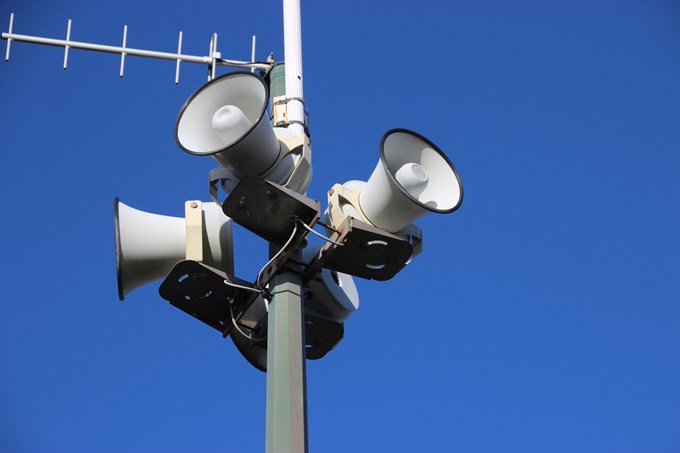Auckland’s next bi-annual tsunami siren testing is happening at 12pm (midday) on Sunday 4 June.
Testing the system ensures we can check it is working as expected. Located in a number of coastal locations, sirens make a combination of alert sounds and voice instructions advising what actions residents should take in a real emergency. During the test, no action is needed from the public.
What does a siren test sound like?
- Voice instructions say, “Attention Please. This is a test of the Auckland Emergency Management tsunami siren network. The next sound you hear will be the standard emergency warning signal.”
- Siren tone sounds (5x “whoops”)
- Voice instructions say, “In the event of a siren activation, follow the instructions that accompany this signal. Thank you.”
<Siren test ends>
Check and listen to the siren sound sample on the Auckland Emergency Management website [.WAV].
Where are tsunami warning sirens located in Auckland?
Rodney: Point Wells, Whangateau, Omaha
Albany Ward: Waiwera, Ōrewa, Hobsonville, Herald Island
Waitākere: Bethells / Te Henga, Piha North, Piha South, Karekare, Whatipu, Little Huia, Te Atatū South, Te Atatū Peninsula North
During this test we will also be checking the performance of any sirens that have been subject to vandalism and thefts. The loss of sirens means the audible warnings for a tsunami threat at these locations are not functioning at full capacity.
If you observe anyone tampering with sirens, please contact the Police immediately. Additionally, if you notice damaged or missing tsunami sirens, call us on 09 301 0101 or report via Auckland Council's report a problem tool.
Emergency Mobile Alert (EMA)
It is important to remember tsunami sirens are not present in all coastal areas in the Auckland region and are not the primary way we inform the public in a tsunami emergency.
Auckland Emergency Management General Manager, Paul Amaral says in the event of an actual tsunami emergency, an Emergency Mobile Alert will be broadcast to all capable mobile phones.
“As well as sending an Emergency Mobile Alert, we will also get the message out through broadcast on radio, television, news media and social media platforms.
“We encourage people to share official messages with others to make sure the message gets out if needed.
“However, if you are at the coast and feel an earthquake which is long or strong, or see other natural warning signs, evacuate immediately to higher ground without waiting for an official alert.”
Remember: LONG or STRONG, GET GONE.
If you feel a strong earthquake that makes it hard to stand up or a weak rolling earthquake that lasts a minute or more, see a sudden rise or fall in sea level, hear loud or unusual noises from the sea, don’t wait for an official warning. Go immediately to the nearest high ground or as far inland as you can, taking the route quickest for you.
What will happen if there is a tsunami and I need to evacuate?
Tsunami testing time is a great reminder to check out whether you live, work, or play in one of Auckland’s three tsunami evacuation zones. Check the Auckland hazard viewer map. We are updating these evacuation maps this year so remember to check back regularly to see if your zone has changed from the previous year.
If you are required to evacuate, you should always follow the instructions of the emergency services. You will need to evacuate to higher ground or as far inland as possible, to an area not covered by evacuation zones. If you are not in an evacuation zone, you do not need to evacuate.
Create an emergency plan for your home and whānau and practice it so everyone knows what to do in an emergency and what you need to take if you are evacuating.
Stay informed and prepared
- Download The Red Cross Hazards App for free from your mobile app store. The app is a useful tool to help you through emergencies and receive disaster alerts for your selected area.
- Check the tsunami preparedness tips and what to do before, during and after a tsunami.
- Make a household emergency plan.
- Follow AEM’s official Facebook and Twitter channels to stay updated.
- For more information, visit Auckland Emergency Management website.
Please note: this siren testing differs from the National Emergency Management Agency’s annual mobile alert test that was held on Sunday 28 May.


